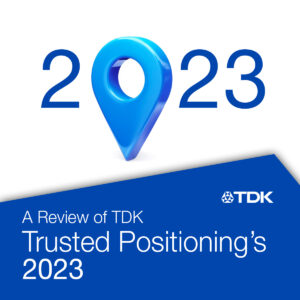Dead Reckoning (DR) technology, rooted in ancient maritime navigation methods, has evolved into a cutting-edge solution for modern positioning challenges. Originally, sailors used dead reckoning to estimate their position based on course and speed, a practice that has since been refined through centuries of advancements in navigation tools and technology. From the development of inertial navigation systems (INS) in aviation to the integration of sophisticated sensors in today’s smartphones and wearables, DR now offers unparalleled accuracy in GPS-denied environments. PDR is the application of DR for wearables on a person or animal. It is used primarily to duty cycle GPS off and on, to save battery life in a wearable. Trusted Positioning has harnessed this technology, transforming it into a vital tool for seamless and reliable navigation. In this article, we delve into the intricacies of PDR, exploring its mechanisms, benefits, applications, and future prospects.
Understanding Pedestrian Dead Reckoning (PDR)
1. The Basics of PDR: Pedestrian Dead Reckoning is a method that estimates a person’s position relative to a known starting point. Unlike GPS, which relies on satellite signals, PDR utilizes onboard sensors in smartphones or wearables. These sensors include accelerometers, gyroscopes, and magnetometers, which work together to detect step count, stride length, and heading. By integrating this data, PDR continuously updates the user’s position.
2. Key Components of PDR:
- Accelerometers: Measure acceleration forces, which help determine step count and stride length.
- Gyroscopes: Measure rotational motion, providing information on changes in heading.
- Magnetometers: Measure magnetic fields, aiding in the determination of absolute heading by referencing the Earth’s magnetic field.
How PDR Works
1. Step Detection and Stride Length Estimation: The accelerometer captures the vertical oscillations associated with walking. By identifying these oscillations, the system counts steps. Stride length is estimated based on the magnitude of these oscillations and personal calibration data, which can be fine-tuned over time for accuracy.
2. Heading Determination: The gyroscope and magnetometer work in tandem to determine the user’s heading. The gyroscope tracks changes in direction by measuring angular velocity, while the magnetometer provides a reference to true north, ensuring the heading is accurate even over extended periods.
3. Position Update: Each step, combined with stride length and heading, allows the system to update the user’s position incrementally. This process, repeated continuously, provides a real-time estimate of the user’s location relative to the starting point.
Benefits of PDR
1. GPS Power Saving: One of the standout benefits of PDR is its effectiveness when GPS is not available due to duty cycling to save power consumption or during poor GPS reception. When outdoors, under canopy, in urban or country canyons where GPS signals are weak or nonexistent, PDR continues to provide reliable position estimates.
2. Seamless Integration with GPS: PDR complements GPS outdoors. When combined, PDR fills in gaps where GPS signals are weak or intermittent. This hybrid approach ensures continuous tracking, enhancing the user experience.
3. Power Efficiency: By intermittently duty cycling the GPS on and off, PDR significantly helps conserves battery life. The sensors used in PDR consume less power compared to continuous GPS usage, making it an efficient alternative for extending battery life in power sensitive applications.
Applications of PDR
1. Fitness and Health Tracking: Wearable fitness devices leveraging Trusted Positioning’s PDR technology offer tracking of position as well as activities such as walking, running, and hiking. These devices utilize accelerometers, gyroscopes, and magnetometers embedded in wearables to determine a user’s position/path, monitor step count, stride length, and distance covered. This data collection enhances health monitoring and fitness tracking, providing users with accurate insights into their physical activity. Trusted Positioning’s PDR technology ensures that even in GPS-denied areas or when GPS is turned off, engineers can achieve their power suage goals to ensure a great user experience.
2. Indoor Workforce Tracking: Trusted Positioning’s VENUE technology combines the strengths of PDR with other positioning signals to offer robust workforce tracking solutions indoors. In environments such as factories, warehouses, and large office buildings, where GPS signals are generally unreliable, VENUE ensures accurate tracking of employees’ movements through the space. By integrating PDR with Magnetic, Wi-Fi, and Bluetooth, VENUE provides a seamless and continuous tracking solution. This enhances operational efficiency, safety, and coordination in various industries, ensuring that workforce movements are monitored accurately in real time. Whether tracking the location of employees for safety purposes or optimizing workflow and productivity, Trusted Positioning’s VENUE technology stands out as a comprehensive solution.
Challenges and Limitations
1. Sensor Calibration and Drift: One of the primary challenges with PDR is sensor drift and the need for accurate calibration. Over time, inertial sensors experience drift, leading to cumulative errors in position estimates. Regular calibration and sophisticated algorithms are required to mitigate this issue.
2. Variability in Stride Length: Stride length can vary due to factors such as walking speed, terrain, and individual biomechanics. Accurate stride length estimation is crucial for reliable position tracking, necessitating continuous adaptation and learning algorithms.
3. Integration with other Technologies: Integrating PDR with other positioning technologies, such as GPS, Wi-Fi, Bluetooth, and Geomagnetic can be complex. Ensuring seamless handover and data fusion requires advanced algorithms and extensive testing.
The Future of PDR
1. Advances in Sensor Technology: Continuous improvements in sensor technology, including higher accuracy and lower power consumption, will enhance the performance of PDR systems. Emerging sensors with advanced capabilities will further reduce errors and improve reliability.
2. Machine Learning and AI: Incorporating machine learning and AI algorithms can significantly enhance PDR accuracy. These technologies can learn individual walking patterns, adapt to different environments, and predict stride length variations, reducing errors over time.
3. Integration with Augmented Reality (AR): PDR can play a crucial role in AR applications, providing accurate position estimates for indoor navigation and interactive experiences. As AR technology advances, the integration of PDR will become increasingly important for immersive and seamless user experiences.
Pedestrian Dead Reckoning is a transformative technology that addresses the limitations of traditional GPS in positioning. By leveraging sensors in smartphones and wearables, PDR provides continuous, accurate position tracking, even in challenging environments. Its applications span various domains, from indoor navigation and fitness tracking to asset tracking in warehouses.
As technology advances, the integration of machine learning, AI, and improved sensors will further enhance the capabilities of PDR. This continuous evolution promises to make PDR an indispensable tool in the navigation and positioning landscape, offering reliable, efficient, and accurate tracking solutions for a wide range of applications.

